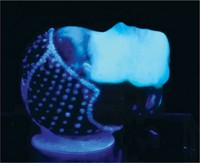Advertisement
Grab your lab coat. Let's get started
Welcome!
Welcome!
Create an account below to get 6 C&EN articles per month, receive newsletters and more - all free.
It seems this is your first time logging in online. Please enter the following information to continue.
As an ACS member you automatically get access to this site. All we need is few more details to create your reading experience.
Not you? Sign in with a different account.
Not you? Sign in with a different account.
ERROR 1
ERROR 1
ERROR 2
ERROR 2
ERROR 2
ERROR 2
ERROR 2
Password and Confirm password must match.
If you have an ACS member number, please enter it here so we can link this account to your membership. (optional)
ERROR 2
ACS values your privacy. By submitting your information, you are gaining access to C&EN and subscribing to our weekly newsletter. We use the information you provide to make your reading experience better, and we will never sell your data to third party members.
Materials
One Biomaterial Composition Won’t Work For All Applications
Changes in tissue microenvironment with disease state affect biomaterial performance
by Celia Henry Arnaud
February 2, 2015
| A version of this story appeared in
Volume 93, Issue 5
Tissue microenvironment affects the performance of implanted biomaterials, suggesting that one implant composition won’t work for all applications, according to a report in Science Translational Medicine (2015, DOI: 10.1126/scitranslmed.aaa1616). Natalie Artzi of MIT and Harvard Medical School and coworkers assessed interactions between an adhesive biomaterial and healthy or diseased colon tissue. The biomaterial is a hydrogel formed from the reaction of dendrimer amines and dextran aldehyde. It functions as an adhesive by reacting with amines in proteins on tissue surfaces. The number of available surface amines determines how strongly the biomaterial holds tissue together. The researchers tested the biomaterial in a rat model of colon cancer and a rabbit model of inflammatory colitis. The adhesive holds cancer tissue together better than healthy tissue because the cancerous one has more surface amines. In contrast, in inflamed tissue, adhesion decreases with increasing severity of the disease. By using a fluorescence assay to determine the distribution of surface amines in tissues, the researchers were able to tune adhesion by adjusting the composition of the biomaterial. “Rational design of biomaterials with an eye toward patient-specific tailored materials is the next step in precision medicine that would potentially lead to improved clinical outcomes,” Artzi says.






Join the conversation
Contact the reporter
Submit a Letter to the Editor for publication
Engage with us on Twitter